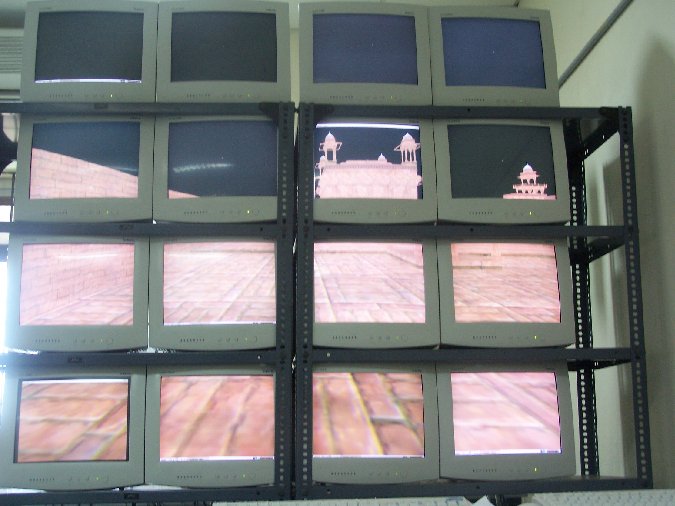The Garuda: A Scalable, Geometry Managed Display Wall
Introduction
Cluster-based tiled display walls simultaneously provide high resolution and large display area (Focus + Context) and are suitable for many applications. They are also cost-effective and scalable with low incremental costs. Garuda is a client-server based display wall solution designed to use off-the-shelf graphics hardware and standard Ethernet network. Garuda uses an object-based scene structure represented using a scene graph. The server determines the objects visible to each display-tile using a novel adaptive algorithm that culls an object hierarchy to a frustum hierarchy. Required parts of the scenegraph are transmitted to the clients which cache them to exploit inter-frame redundancy in the scene. A multicast-based protocol is used to transmit the geometry exploiting the spatial redundancy present especially on large tiled displays. A geometry push philosophy from the server helps keep the clients in sync with one another. No node including the server needs to render the entire environment, making the system suitable for interactive rendering of massive models. Garuda is built on the Open scene graph system and can transparently render any OSG-based application to a tiled display wall without any modification by the user.
Features
The Garuda System provides ::
- Cluster based large display solution: Low in cost, easier to maintain and scale than Monolithic solutions.
- Focus and Context: Renders large scenes with high detail, user is able to see the entirety of the scene along with fine details.
- Driven from Graphics, not images: Interactive applications. Not only increase in size but also in resolution.
- Parallel Rendering: Distributed rendering capabilities of a cluster used for parallel rendering. No individual system has to render the entire scene.
- Transparent Rendering for OSG: More applicability, any Open Scene Graph application can be rendered to the system without any modification.
- Capability to handle dynamic scenes: The system can handle dynamic OSG environment rendering at interactive frame rates.
- Low Network Load: The system has very low network requirements owing to a Server push philosophy and caching at clients.
 Features of The Garuda System ::
Features of The Garuda System ::
- Scalable to large tile configurations, up to 7x7 tile sizes on single server. A hierarchy of servers can be used to support even larger tile sizes.
- Caching at the clients and use of multicast keeps the network requirements low, the system can handle huge tile configurations on a single 100Mbps network.
- Using a novel culling algorithm the system scales sub-linearly to arbitrary large tile configurations. Please see: Adaptive Culling Algorithm for details.
- No recompilation or relinking of OSG code necessary for rendering to a display wall.
- Using distributed rendering the system can render massive models which could not be rendered at interactive frame rates using a single machine.
Related Publications
Nirnimesh, Pawan Harish and P. J. Narayanan - Garuda: A Scalable, Tiled Display Wall Using Commodity PCs Proc. of IEEE Transactions on Visualization and Computer Graphics(TVCG), Vol.13, no.~5, pp.864-877, 2007. [PDF]
Nirnimesh, Pawan Harish and P. J. Narayanan - Culling an Object Hierarchy to a Frustum Hierarchy, 5th Indian Conference on Computer Vision, Graphics and Image Processing, Madurai, India, LNCL 4338 pp.252-263,2006. [PDF]
Associated People
- Pawan Harish
- Nirnimesh
- Prof. P. J. Narayanan
